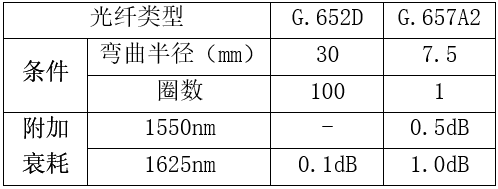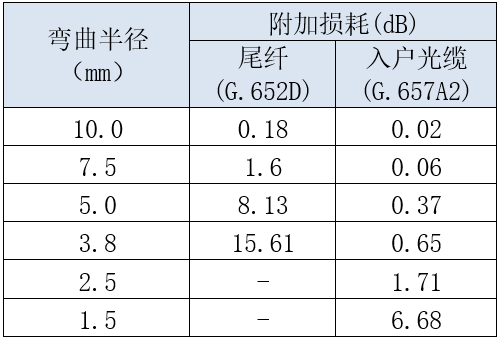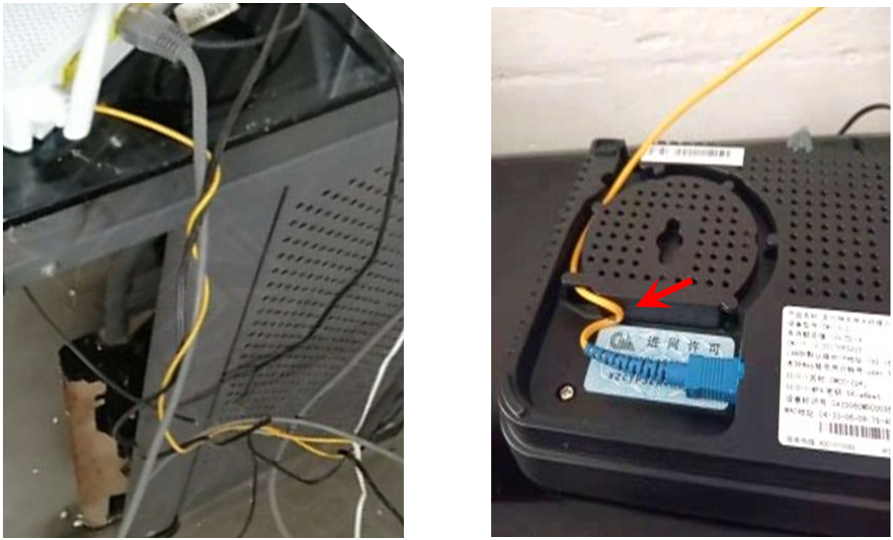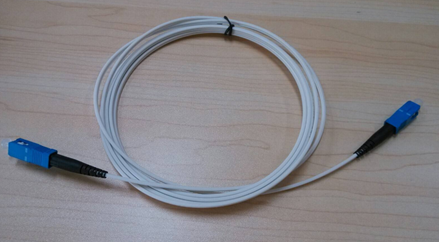G.657 fiber, also known as bending loss insensitive fiber, is used in the cable that FTTH enters the home, which is thinner than an ordinary telephone line. Without G.657 fiber, there would be no large-scale application of FTTH. G.657 fiber is divided into several subcategories, the current common is G.657A2.

G.652 optical fiber is the most widely used optical fiber in the metropolitan area network, except for FTTH household optical fiber, the basic use of other communication optical fiber in the metropolitan area is G.652 optical fiber. G.652 fiber is divided into four subcategories, the current general use is G.652D.
Compared with G.652D fiber, how strong is the bending resistance of G.657A2 fiber?
2 The minimum bending radius of G.657 and G.652 optical fibers is specified in the standard
In the relevant standards, the minimum bending radius of the G.657A2 fiber is recommended to be 7.5 mm, and the minimum bending radius of the G.652 fiber is required to be no less than 30mm, but the meaning of the minimum bending radius is completely different here.
G. The minimum bending radius of the 657A2 optical fiber means that the optical fiber is loosely wound once with a 7.5 mm radius, and the additional loss measured at 1550nm or 1625nm does not exceed 0.5 dB/ 1.0 dB respectively.
G. The minimum bending radius of the 652D fiber means that the fiber is loosely wound 100 times with a radius of 30mm, and the additional loss measured at 1625nm does not exceed 0.1 dB.
The additional loss caused by fiber bending when the bending radius is much larger than its diameter is called macro bending loss. The macro bending characteristics of G.657A2 fiber and G.652D fiber are shown in the following table.

Obviously, the minimum bending radius of the G.657A2 fiber is not comparable to that of the G.652D fiber here.
3 Measurement of bending resistance of G.657 and G.652 fiber
When the FTTH household optical cable is installed, in order to facilitate the end of the household optical cable, the installation and maintenance personnel often fuse the FTTH household optical cable to a small section of pigtail fiber at the cable sub-box and ONT(commonly known as "light cat"), the fiber type in the pigtail fiber is G.652D, and the fiber type in the FTTH household optical cable is G.657A2.
Because the pigtail and the cable to the home are in the same laying environment and have the same size (the diameter of the pigtail is 2.0mm, and the diameter of the short/long axis of the cable to the home is 2.0mm / 3.0mm), it is more practical to compare the bending resistance of the pigtail and the cable to the home, and it can basically reflect the difference in the bending resistance of the G.652D and G.657A2 fiber.
Since the macro bending loss of the fiber in ODN is mainly affected by the downlink wavelength (see "The Effect of Insufficient Fiber Bending Radius on ODN Link loss"), only the additional loss of the pigtail and the in-home cable at 1490nm wavelength with different radii was tested.
The test results are shown in the table below.

It can be seen from the test results that the bending resistance of the incoming optical cable (G.657A2) is several streets higher than that of the tail fiber (G.652D), especially under the small bending radius, the bending resistance of the incoming optical cable is better.
4 Conclusions and Suggestions
Because there is a huge difference in the bending resistance between G.657 and G.652 fiber, and the pigtail fiber itself is relatively soft, it is very easy to produce a small radius of bending, as shown in the following figure.

According to the statistical data of a MAN installation and maintenance failure, the proportion of installation and maintenance failure caused by insufficient pigtail bending radius is as high as 50%, so it is not advisable to use pigtail to form the end of the household optical cable when FTTH is installed, and pre-formed butterfly optical cable (as shown in the figure below) should be used to install and form the end.

Address: Xuanwu Lake, Xuanwu District, Nanjing City, Jiangsu Province Copyright © 2022 Hardware Machinery All Rights Reserved< a href=" https://beian.miit.gov.cn/ Target="-blank" rel="nofollow">Su ICP123456













